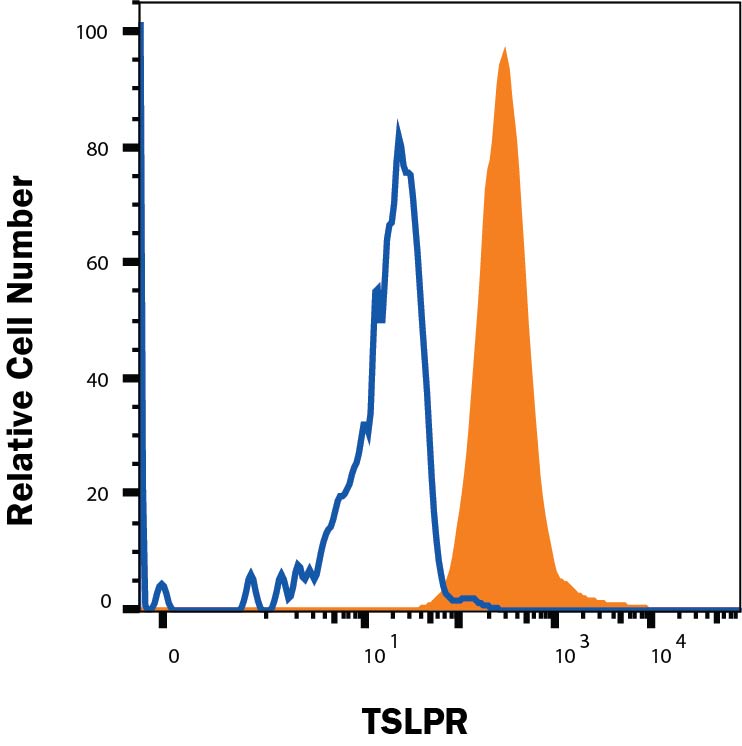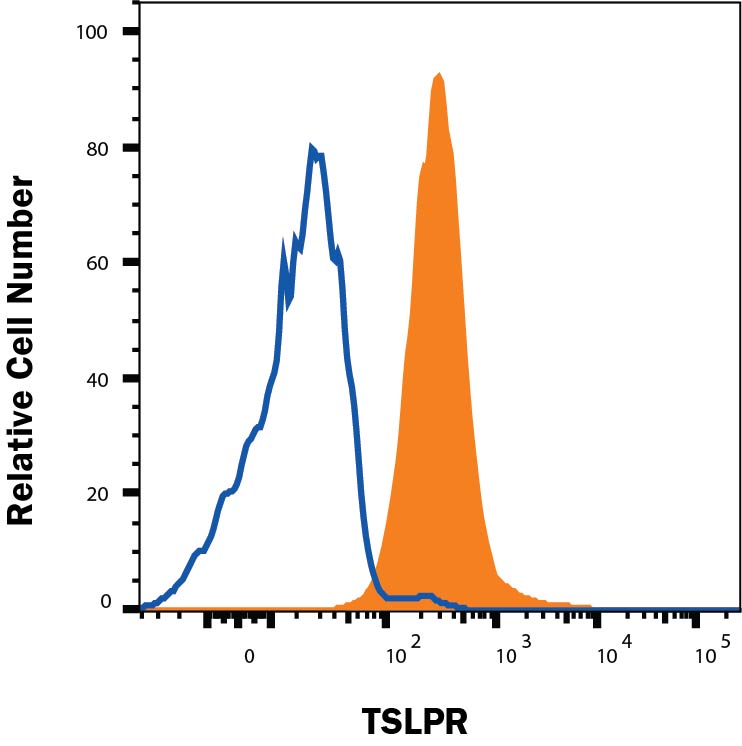Human TSLPR Antibody Summary
Gly25-Lys231
Accession # Q9HC73
Applications
Please Note: Optimal dilutions should be determined by each laboratory for each application. General Protocols are available in the Technical Information section on our website.
Scientific Data
 View Larger
View Larger
Detection of TSLPR in NS0/hTSLPR cells by Flow Cytometry. NS0/hTSLPR cells were stained with Mouse Anti-Human TSLPR Monoclonal Antibody (Catalog # MAB981R, filled histogram) or isotype control antibody (Catalog # MAB002, open histogram), followed by Phycoerythrin-conjugated Anti-Mouse IgG Secondary Antibody (Catalog # F0102B). View our protocol for Staining Membrane-associated Proteins.
 View Larger
View Larger
Detection of TSLPR in NS0 cells by Flow Cytometry. NS0 cells transfected with hTSLPR (A) vs Irrelevant NS0 transfectant cells (B) were stained with Mouse Anti-Human TSLPR Monoclonal Antibody (Catalog # MAB981R, filled histogram) followed by Phycoerythrin-conjugated Anti-Mouse IgG Secondary Antibody (Catalog # F0102B). View our protocol for Staining Membrane-associated Proteins.
Reconstitution Calculator
Preparation and Storage
- 12 months from date of receipt, -20 to -70 °C as supplied.
- 1 month, 2 to 8 °C under sterile conditions after reconstitution.
- 6 months, -20 to -70 °C under sterile conditions after reconstitution.
Background: TSLPR
TSLPR, also named Delta (1) and CRLM-2 (2) (cytokine receptor-like module-2), was originally cloned as a novel type 1 cytokine receptor with similarity to the common gamma chain. It was subsequently identified to be a subunit of the cellular receptor for the IL-7-like cytokine TSLP and termed TSLPR (3). The human TSLPR cDNA encodes a 371 amino acid (aa) residue type 1 membrane protein with a 22 aa residue signal peptide, a 210 aa residue extracellular domain, a 20 aa residue transmembrane domain, and a 119 aa residue cytoplasmic domain (4, 5). The extracellular region contains two fibronectin type III-like domains and a WSXWS-like motif. The cytoplasmic domain contains a membrane-proximal box 1 motif that is known to be important for association with JAKs (4). Human TSLPR displays 39% identity to mouse TSLPR and 24% identity to the common gamma receptor (4). An alternatively spliced mRNA variant encoding a soluble TSLPR has also been reported in mouse (2). TSLPR expression is ubiquitous in the immune and hematopoietic cells, but is up-regulated in Th2-skewed cells. Cells expressing TSLPR alone bind TSLP with low affinity. Co-expression of TSLPR and IL-7 R alpha is required for high-affinity TSLP binding and signal transduction (3‑6). The TSLPR and IL-7 R alpha are co‑expressed primarily on monocytes and dendritic cells and at lower levels in lymphoid cells. TSLP has been shown to induce the release of T cell-attracting chemokines from monocytes and enhance the maturation of CD11c+ dendritic cells (5).
- Fujio, K. et al. (2000) Blood 95:2204.
- Hiroyama, T. et al. (2000) Biochem. Biophys. Res. Commun. 272:224.
- Park, L.S. et al. (2000) J. Exp. Med. 192:659.
- Tonozuka, Y. et al. (2001) Cytogenet. Cell Genet. 93:23.
- Reche, P.A. et al. (2001) J. Immunol. 167:336.
- Pandey, A. et al. (2000) Nat. Immunol. 1:59.
Product Datasheets
FAQs
No product specific FAQs exist for this product, however you may
View all Antibody FAQsReviews for Human TSLPR Antibody
There are currently no reviews for this product. Be the first to review Human TSLPR Antibody and earn rewards!
Have you used Human TSLPR Antibody?
Submit a review and receive an Amazon gift card.
$25/€18/£15/$25CAN/¥75 Yuan/¥2500 Yen for a review with an image
$10/€7/£6/$10 CAD/¥70 Yuan/¥1110 Yen for a review without an image



